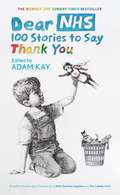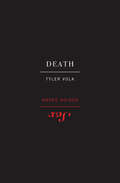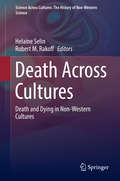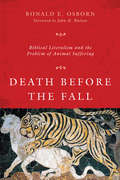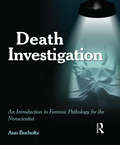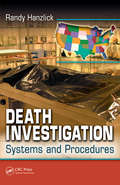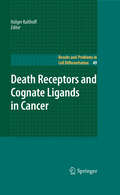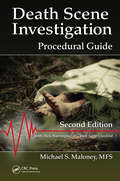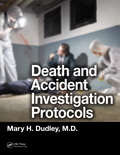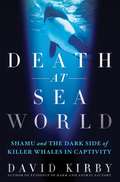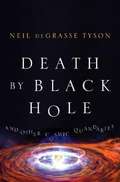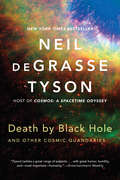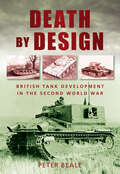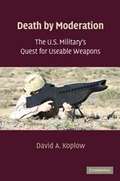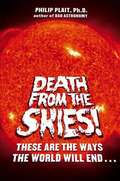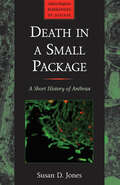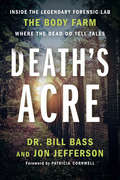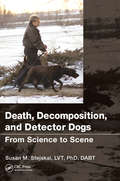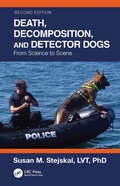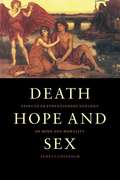- Table View
- List View
Dear NHS: 100 Stories to Say Thank You, Edited by Adam Kay
by VariousTHE NUMBER ONE SUNDAY TIMES BESTSELLERCurated and edited by Adam Kay (author of multi-million bestseller This is Going to Hurt), Dear NHS features 100 household names telling their personal stories of the health service. Contributors include: Paul McCartney, Emilia Clarke, Peter Kay, Stephen Fry, Sir Trevor McDonald, Graham Norton, Sir Michael Palin, Naomie Harris, Sir David Jason, Dame Emma Thompson, Joanna Lumley, Miranda Hart, Jamie Oliver, Ed Sheeran, David Tennant, Dame Julie Walters, Emma Watson, Malala Yousafzai and many, many more. All profits from this book will go to NHS Charities Together to fund vital research and projects, and The Lullaby Trust which supports parents bereaved of babies and young children.Other writers include Jack Whitehall, Chris Evans, Lorraine Kelly, Lee Mack, Jonathan Ross, Konnie Huq, Frank Skinner, KT Tunstall and Sandi Toksvig. The NHS is our single greatest achievement as a country. No matter who you are, no matter what your health needs are, and no matter how much money you have, the NHS is there for you. In Dear NHS, 100 inspirational people come together to share their stories of how the national health service has been there for them, and changed their lives in the process. By turns deeply moving, hilarious, hopeful and impassioned, these stories together become a love letter to the NHS and the 1.4 million people who go above and beyond the call of duty every single day - selflessly, generously, putting others before themselves, never more so than now. They are all heroes, and this book is our way of saying thank you.Contributors include: Dolly Alderton, Monica Ali, Kate Atkinson, Pam Ayres, David Baddiel, Johanna Basford, Mary Beard, William Boyd, Frankie Boyle, Jo Brand, Kevin Bridges, Alex Brooker, Charlie Brooker, Rob Brydon, Bill Bryson, Kathy Burke, Peter Capaldi, Jimmy Carr, Candice Carty-Williams, Lauren Child, Lee Child, Bridget Christie, Emilia Clarke, Rev Richard Coles, Daisy May Cooper, Jilly Cooper, Fearne Cotton, Juno Dawson, Kit de Waal, Victoria Derbyshire, Reni Eddo-Lodge, Chris Evans, Anne Fine, Martin Freeman, Dawn French, Stephen Fry, Mark Gatiss, Ricky Gervais, Professor Green, Baroness Tanni Grey-Thompson, Mark Haddon, Matt Haig, The Hairy Bikers, Naomie Harris, Miranda Hart, Victoria Hislop, Nick Hornby, Sali Hughes, Konnie Huq, Marina Hyde, E L James, Greg James, Sir David Jason, Katarina Johnson-Thompson, Jackie Kay, Peter Kay, Lorraine Kelly, Marian Keyes, Shappi Khorsandi, Nish Kumar, Stewart Lee, Joanna Lumley, Lee Mack, Emily Maitlis, Andrew Marr, Catherine Mayer, Alexander McCall Smith, Paul McCartney, Sir Trevor McDonald, Caitlin Moran, Kate Mosse, Jojo Moyes, David Nicholls, John Niven, Graham Norton, Chris O'Dowd, Dermot O'Leary, Jamie Oliver, Sir Michael Palin, Maxine Peake, Sue Perkins, Katie Piper, Ian Rankin, Jonathan Ross, Ed Sheeran, Paul Sinha, Frank Skinner, Matthew Syed, Kae Tempest, David Tennant, Louis Theroux, Dame Emma Thompson, Sandi Toksvig, Stanley Tucci, KT Tunstall, Johnny Vegas, Danny Wallace, Dame Julie Walters, Phil Wang, Emma Watson, Mark Watson, Robert Webb, Irvine Welsh, Jack Whitehall, Josh Widdicombe, Dame Jacqueline Wilson, Greg Wise, Malala Yousafzai, Benjamin Zephaniah.A minimum of £3.09 from the sale of each book will be paid to NHS Charities Together and £0.16 will be paid to The Lullaby Trust.
Dear NHS: 100 Stories to Say Thank You, Edited by Adam Kay
by VariousTHE NUMBER ONE SUNDAY TIMES BESTSELLERCurated and edited by Adam Kay (author of multi-million bestseller This is Going to Hurt), Dear NHS features 100 household names telling their personal stories of the health service. Contributors include: Paul McCartney, Emilia Clarke, Peter Kay, Stephen Fry, Sir Trevor McDonald, Graham Norton, Sir Michael Palin, Naomie Harris, Sir David Jason, Dame Emma Thompson, Joanna Lumley, Miranda Hart, Jamie Oliver, Ed Sheeran, David Tennant, Dame Julie Walters, Emma Watson, Malala Yousafzai and many, many more. All profits from this book will go to NHS Charities Together to fund vital research and projects, and The Lullaby Trust which supports parents bereaved of babies and young children.Other writers include Jack Whitehall, Chris Evans, Lorraine Kelly, Lee Mack, Jonathan Ross, Konnie Huq, Frank Skinner, KT Tunstall and Sandi Toksvig. The NHS is our single greatest achievement as a country. No matter who you are, no matter what your health needs are, and no matter how much money you have, the NHS is there for you. In Dear NHS, 100 inspirational people come together to share their stories of how the national health service has been there for them, and changed their lives in the process. By turns deeply moving, hilarious, hopeful and impassioned, these stories together become a love letter to the NHS and the 1.4 million people who go above and beyond the call of duty every single day - selflessly, generously, putting others before themselves, never more so than now. They are all heroes, and this book is our way of saying thank you.Contributors include: Dolly Alderton, Monica Ali, Kate Atkinson, Pam Ayres, David Baddiel, Johanna Basford, Mary Beard, William Boyd, Frankie Boyle, Jo Brand, Kevin Bridges, Alex Brooker, Charlie Brooker, Rob Brydon, Bill Bryson, Kathy Burke, Peter Capaldi, Jimmy Carr, Candice Carty-Williams, Lauren Child, Lee Child, Bridget Christie, Emilia Clarke, Rev Richard Coles, Daisy May Cooper, Jilly Cooper, Fearne Cotton, Juno Dawson, Kit de Waal, Victoria Derbyshire, Reni Eddo-Lodge, Chris Evans, Anne Fine, Martin Freeman, Dawn French, Stephen Fry, Mark Gatiss, Ricky Gervais, Professor Green, Baroness Tanni Grey-Thompson, Mark Haddon, Matt Haig, The Hairy Bikers, Naomie Harris, Miranda Hart, Victoria Hislop, Nick Hornby, Sali Hughes, Konnie Huq, Marina Hyde, E L James, Greg James, Sir David Jason, Katarina Johnson-Thompson, Jackie Kay, Peter Kay, Lorraine Kelly, Marian Keyes, Shappi Khorsandi, Nish Kumar, Stewart Lee, Joanna Lumley, Lee Mack, Emily Maitlis, Andrew Marr, Catherine Mayer, Alexander McCall Smith, Paul McCartney, Sir Trevor McDonald, Caitlin Moran, Kate Mosse, Jojo Moyes, David Nicholls, John Niven, Graham Norton, Chris O'Dowd, Dermot O'Leary, Jamie Oliver, Sir Michael Palin, Maxine Peake, Sue Perkins, Katie Piper, Ian Rankin, Jonathan Ross, Ed Sheeran, Paul Sinha, Frank Skinner, Matthew Syed, Kae Tempest, David Tennant, Louis Theroux, Dame Emma Thompson, Sandi Toksvig, Stanley Tucci, KT Tunstall, Johnny Vegas, Danny Wallace, Dame Julie Walters, Phil Wang, Emma Watson, Mark Watson, Robert Webb, Irvine Welsh, Jack Whitehall, Josh Widdicombe, Dame Jacqueline Wilson, Greg Wise, Malala Yousafzai, Benjamin Zephaniah.A minimum of £3.09 from the sale of each book will be paid to NHS Charities Together and £0.16 will be paid to The Lullaby Trust.
Death & Sex
by Dorion Sagan Tyler VolkWhat is shared by spawning Pacific salmon, towering trees, and suicidal bacteria? In his lucid and concise exploration of how and why things die, Tyler Volk explains the intriguing ways creatures-including ourselves-use death to actually enhance life. The exquisite schemes and styles of death that have emerged from evolution have been essential to the great story from life's beginnings in tiny bacteria to ancient human rituals surrounding death and continuing to the existential concerns of human culture and consciousness today. Volk weaves together autobiography, biology, Earth history, and results of fascinating studies that show how thoughts of our own mortality affect our everyday lives, to prove how an understanding of what some have called the ultimate taboo can enrich the celebration of life. In Sex, Dorion Sagan takes a delightful, irreverent, and informative romp through the science, philosophy, and literature of humanity's most obsessive subject. Linking evolutionary biology to salacious readings of the lives and thoughts of such notables as the Marquis de Sade and Simone de Beauvoir, and discussing works as varied as The Story of O and Silence of the Lambs, Sex touches on a potpourri of interrelated topics ranging from animal genitalia to sperm competition, the difference between nakedness and nudity, jealousy's status as an aphrodisiac and the origins of language, Casanova and music, ovulation and clothes, mother-in-law jokes and alpha females, love and loneliness. Two books in one cover, Death & Sex unravel and answer some of life's most fundamental questions.
Death Across Cultures: Death and Dying in Non-Western Cultures (Science Across Cultures: The History of Non-Western Science #9)
by Helaine Selin Robert M. RakoffDeath Across Cultures: Death and Dying in Non-Western Cultures, explores death practices and beliefs, before and after death, around the non-Western world. It includes chapters on countries in Africa, Asia, South America, as well as indigenous people in Australia and North America. These chapters address changes in death rituals and beliefs, medicalization and the industry of death, and the different ways cultures mediate the impacts of modernity. Comparative studies with the west and among countries are included. This book brings together global research conducted by anthropologists, social scientists and scholars who work closely with individuals from the cultures they are writing about.
Death Before the Fall: Biblical Literalism and the Problem of Animal Suffering
by Ronald E. Osborn2014 ECPA Top Shelf Book Cover Award
Death Investigation: An Introduction to Forensic Pathology for the Nonscientist
by Ann BucholtzDeath Investigation: An Introduction to Forensic Pathology for the Nonscientist provides students and law enforcement professionals with an accurate, clear overview of forensic pathology. It presents death investigation at the scene and autopsy, providing readers with a broad understanding of forensic pathology and giving them a clear picture of what happens after the examination of the scene. Readers learn what first responders should (and should not) do at the scene, and get a forensic pathologist's perspective on the importance of preserving evidence. Death Investigation methodically explains what happens during autopsy to determine cause and manner of death -- including particulars of blunt force trauma, sharp force injuries, asphyxia, and gunshot wounds -- and how findings are presented in court. Written for a criminal justice audience by a practicing forensic pathologist and educator, Death Investigation makes challenging forensics concepts accessible to nonscientists.
Death Investigation: Systems and Procedures
by Randy Hanzlick M.D.Death Investigation: Systems and Procedures is the first book dedicated to the topic of death investigation from a legal standpoint as well as the administrative and operational procedures that pertain to the medical examiner and the coroner system in the United States. Unique in its perspective, this book is the only one not concerned with instruc
Death Receptors and Cognate Ligands in Cancer
by Holger KalthoffDeath receptors play a central role in directing apoptosis in mammalian cells. This process of active cell death is important for a number of biological processes, e.g. for the regulation of the immune system. Death receptors are cell surface receptors that transmit apoptotic signals initiated by corresponding death ligands. Many complex signaling pathways are activated and apoptosis is the final result of a complex biochemical cascade of events. Besides their role in the induction of cell death, evidence now exists that death receptors are able to activate several non-apoptotic signaling pathways which, depending on cellular context, may lead to apoptosis resistance, secretion of pro-inflammatory proteins, proliferation and invasive growth of cancer cells. This book looks at the molecular basis of death receptor signaling and the role of death receptors in cancer development.
Death Scene Investigation: Procedural Guide, Second Edition
by Michael S. MaloneyThose tasked with investigating death scenes come from a variety of backgrounds and varying levels of experience. Whether a homicide detective, crime scene investigator, medico-legal death investigator, coroner or medical examiner, Death Scene Investigation: Procedural Guide, Second Edition provides the investigator best-practice techniques and procedures for almost any death scene imaginable, including for deaths occurring even under the most unusual of circumstances. This Second Edition is fully updated to include new coverage on shallow graves, human remains at crime scenes, poisonings, expanded coverage of projectile weapons, videography, touch DNA, death notifications, and a newly added chapter dedicated to sexual deaths. In addition, the book serves as an on-scene ready reference which includes instructions on procedure including the initial notification of a death, processing the scene and body, the investigator's role at autopsy, and analyzing the scene indicators to place evidence into context. Topics discussed include: Initial response and scene evaluation Death scene management including documentation, sketching, photography, videography, observations, and search procedures A special death investigation matrix that walks the investigator though a decision tree to help in ambiguous deaths Contains discussion of all manners of death, including accident, suicide, natural and homicide Coverage of recovery of human remains from open field, aquatic, and buried sites including estimating the time of death. Wound dynamics and mechanisms of injury that covers asphyxiation, sharp and blunt force trauma, chopping injuries; handgun, rifle, and shotgun wounds, electrical injuries, and more The bulleted format and spiral binding allows for easy use and reference in the field with sections that are self-contained and cross-referenced for quick searches. With its thorough and detailed approach, Death Scene Investigation, Second Edition will be a must-have addition to any crime scene and death investigator’s tool kit.
Death Scenes
by Sean Tejaratchi Dunn KatherineThe strange and gruesome crime-scene snapshot collection of LAPD detective Jack Huddleston spans Southern California in its noir heyday. Death Scenes is the noted forerunner of several copycat titles.
Death Valley Rocks & Minerals (Destinations In Science)
by David C. BrummettDeath Valley impresses more than a million visitors each year, and anyone with a feeling for geology surely considers it a choice destination. It is a vast showcase of rocks and landforms, testifying to geologic events over billions of years. And most compelling for specialists, Death Valley displays the evidence and effects of extreme crustal extension, revealing the rarely seen doings of the deep crust in a setting where the faults and rocks are exposed in extraordinary detail.
Death and Accident Investigation Protocols
by Mary H. DudleyThrough an examination and assessment of the body at a death scene, the medicolegal death investigator (MLDI) must be able to recognize circumstances that point to what manner of death occurred—be it natural causes, homicide, suicide, accident, or undetermined. A handy reference for use in the field and in the lab, Death and Accident Investigation Protocols provides 34 checklists and forms to help investigators make these determinations.Categories of death covered in this guide include: Aircraft and motor vehicle accident Alcohol- and drug-related Blunt- and sharp-force injury Drowning Electrocution, exposure, and fire Gunshot Hanging Hospital- and nursing home-related Infectious disease Natural causes Occupational exposure Poison and toxic substances Sexual assault Suicide Formatted as a convenient 8 ½ x 11 spiral-bound book, this manual helps investigators know what to look for, what questions to ask, and how to categorize the scene and the physical injuries. The forms in the book can either be downloaded, which allows for easy form modification. The text includes descriptive illustrations and diagrams associated with various categories of death. An essential tool for the busy investigator, the book facilitates the organization of information for a myriad of death scenarios.
Death and the Body in the Eighteenth-Century Novel
by Jolene ZigarovichDeath and the Body in the Eighteenth-Century Novel demonstrates that archives continually speak to the period’s rising funeral and mourning culture, as well as the increasing commodification of death and mourning typically associated with nineteenth-century practices. Drawing on a variety of historical discourses—such as wills, undertaking histories, medical treatises and textbooks, anatomical studies, philosophical treatises, and religious tracts and sermons—the book contributes to a fuller understanding of the history of death in the Enlightenment and its narrative transformation.Death and the Body in the Eighteenth-Century Novel not only offers new insights about the effect of a growing secularization and commodification of death on the culture and its productions, but also fills critical gaps in the history of death, using narrative as a distinct literary marker. As anatomists dissected, undertakers preserved, jewelers encased, and artists figured the corpse, so too the novelist portrayed bodily artifacts. Why are these morbid forms of materiality entombed in the novel? Jolene Zigarovich addresses this complex question by claiming that the body itself—its parts, or its preserved representation—functioned as secular memento, suggesting that preserved remains became symbols of individuality and subjectivity. To support the conception that in this period notions of self and knowing center upon theories of the tactile and material, the chapters are organized around sensory conceptions and bodily materials such as touch, preserved flesh, bowel, heart, wax, hair, and bone. Including numerous visual examples, the book also argues that the relic represents the slippage between corpse and treasure, sentimentality and materialism, and corporeal fetish and aesthetic accessory.Zigarovich’s analysis compels us to reassess the eighteenth-century response to and representation of the dead and dead-like body, and its material purpose and use in fiction. In a broader framework, Death and the Body in the Eighteenth-Century Novel also narrates a history of the novel that speaks to the cultural formation of modern individualism.
Death at Seaworld: Shamu and the Dark Side of Killer Whales in Captivity
by David KirbyFrom the New York Times bestselling author of Evidence of Harm and Animal Factory- a groundbreaking scientific thriller that exposes the dark side of SeaWorld, America's most beloved marine mammal park. Death at SeaWorld centers on the battle with the multimillion-dollar marine park industry over the controversial and even lethal ramifications of keeping killer whales in captivity. Following the story of marine biologist and animal advocate at the Humane Society of the US, Naomi Rose, Kirby tells the gripping story of the two-decade fight against PR-savvy SeaWorld, which came to a head with the tragic death of trainer Dawn Brancheau in 2010. Kirby puts that horrific animal-on-human attack in context. Brancheau's death was the most publicized among several brutal attacks that have occurred at Sea World and other marine mammal theme parks. Death at SeaWorld introduces real people taking part in this debate, from former trainers turned animal rights activists to the men and women that champion SeaWorld and the captivity of whales. In section two the orcas act out. And as the story progresses and orca attacks on trainers become increasingly violent, the warnings of Naomi Rose and other scientists fall on deaf ears, only to be realized with the death of Dawn Brancheau. Finally he covers the media backlash, the eyewitnesses who come forward to challenge SeaWorld's glossy image, and the groundbreaking OSHA case that challenges the very idea of keeping killer whales in captivity and may spell the end of having trainers in the water with the ocean's top predators.
Death by Black Hole: And Other Cosmic Quandaries
by Neil Degrasse TysonTouching on just about everything you want to know about the cosmos, this collection of essays by Tyson, an astrophysicist at the American Museum of Natural History and columnist for Natural History, explores topics from astral life to the movie industry's attempts to represent the night skies. In clear and witty prose, Tyson introduces the physics of black holes by describing what would happen if someone fell in, examines the needless friction between science and religion, and tells an ego-deflating story of Earth's progression from the center of the universe to a "small speck in the cosmos." Annotation ©2007 Book News, Inc., Portland, OR (booknews.com)
Death by Black Hole: And Other Cosmic Quandaries
by Neil deGrasse Tyson"[Tyson] tackles a great range of subjects…with great humor, humility, and—most important—humanity." —Entertainment Weekly Loyal readers of the monthly "Universe" essays in Natural History magazine have long recognized Neil deGrasse Tyson's talent for guiding them through the mysteries of the cosmos with clarity and enthusiasm. Bringing together more than forty of Tyson's favorite essays, Death by Black Hole explores a myriad of cosmic topics, from what it would be like to be inside a black hole to the movie industry's feeble efforts to get its night skies right. One of America's best-known astrophysicists, Tyson is a natural teacher who simplifies the complexities of astrophysics while sharing his infectious fascination for our universe.
Death by Design: British Tank Development in the Second World War
by Peter BealeAt the outbreak of war in 1939 British tank crews were ill-equipped, under trained and badly led. As a consequence the lives of hundreds of crewmen were wasted unnecessarily. This was due not only to the poor design and construction of British tanks, but also to the lack of thought and planning on the part of successive pre-war governments and the War Office. Death by Design explores how and why Britain went from leading the world in tank design at the end of the First World War to lagging far behind the design quality of Russian and German tanks in the Second World War. This book is a much-needed warning to governments and military planners: a nation must always be prepared to defend itself and ensure that its soldiers are equipped with the tools to do so.
Death by Moderation: The U. S. Military's Quest for Useable Weapons
by David A. KoplowThis book addresses an important but little-noticed phenomenon in the revolutionary world of military technology. Across a wide range of otherwise-unrelated weapons programs, the Pentagon is now pursuing arms that are deliberately crafted to be less powerful, less deadly, and less destructive than the systems they are designed to supplement or replace. This direction is historically anomalous; military forces generally pursue ever-bigger bangs, but the modern conditions of counter-insurgency warfare and military operations "other than war" (such as peacekeeping and humanitarian assistance) demand a military capable of modulated force. By providing a capacity to intervene deftly yet effectively, the new generations of "useable" weaponry should enable the U.S. military to accomplish its demanding missions in a manner consistent with legal obligations, public relations realities, and political constraints. Five case studies are provided, regarding precision-guided "smart bombs," low-yield nuclear weapons, self-neutralizing anti-personnel land mines, directed-energy anti-satellite weapons, and non-lethal weapons.
Death from the Skies! These Are the Ways the World Will End
by Plait PhilipA lively astronomy primer that uses cataclysmic scenarios to explain the universe's most fascinating events. According to astronomer Philip Plait, the universe is an apocalypse waiting to happen But how much do we really need to fear from things like black holes, gamma-ray bursts, and supernovae? And if we should be scared, is there anything we can do to save ourselves? With humor and wit, Plait details the myriad doomsday events that the cosmos could send our way to destroy our planet and life as we know it. This authoritative yet accessible study is the ultimate astronomy lesson. Combining fascinating?and often alarming?scenarios that seem plucked from science fiction with the latest research and opinions, Plait illustrates why outer space is not as remote as most people think. Each chapter explores a different phenomenon, explaining it in easy-to-understand terms, and considering how life on earth and the planet itself would be affected should the event come to pass. Rather than sensationalizing the information, Plait analyzes the probability of these catastrophes occurring in our lifetimes and what we can do to stop them. With its entertaining tone and enlightening explanation of unfathomable concepts, Death from the Skies! will appeal to science buffs and beginners alike. .
Death in a Small Package: A Short History of Anthrax (Johns Hopkins Biographies of Disease)
by Susan D. JonesA look at the historical development of the lethal disease and its relationship with humanity.A disease of soil, animals, and people, anthrax has threatened lives for at least two thousand years. Farmers have long recognized its lasting virulence, but in our time, anthrax has been associated with terrorism and warfare. What accounts for this frightening transformation? Death in a Small Package recounts how this ubiquitous agricultural disease came to be one of the deadliest and most feared biological weapons in the world.Bacillus anthracis is lethal. Animals killed by the disease are buried deep underground, where anthrax spores remain viable for decades or even centuries and, if accidentally disturbed, can cause new infections. But anthrax can be deliberately aerosolized and used to kill—as it was in the United States in 2001.Historian and veterinarian Susan D. Jones recounts the life story of anthrax through the biology of the bacillus; the political, economic, geographic, and scientific factors that affect anthrax prevalence; and the cultural beliefs about the disease that have shaped human responses to it. She explains how Bacillus anthracis became domesticated, discusses what researchers have learned from numerous outbreaks, and analyzes how the bacillus came to be weaponized and what this development means for the modern world.Jones compellingly narrates the biography of this frightfully hardy disease from the ancient world through the present day.“Death in a Small Package is interesting, well written, and accessible, presenting a worthwhile addition to the history of modern medicine and bacteriological science.” —Karen Brown, Isis
Death in a Small Package: A Short History of Anthrax (Johns Hopkins Biographies of Disease)
by Susan D. JonesA disease of soil, animals, and people, anthrax has threatened lives for at least two thousand years. Farmers have long recognized its lasting virulence, but in our time, anthrax has been associated with terrorism and warfare. What accounts for this frightening transformation? Death in a Small Package recounts how this ubiquitous agricultural disease came to be one of the deadliest and most feared biological weapons in the world.Bacillus anthracis is lethal. Animals killed by the disease are buried deep underground, where anthrax spores remain viable for decades or even centuries and, if accidentally disturbed, can cause new infections. But anthrax can be deliberately aerosolized and used to kill—as it was in the United States in 2001. Historian and veterinarian Susan D. Jones recounts the life story of anthrax through the biology of the bacillus; the political, economic, geographic, and scientific factors that affect anthrax prevalance; and the cultural beliefs about the disease that have shaped human responses to it. She explains how Bacillus anthracis became domesticated, discusses what researchers have learned from numerous outbreaks, and analyzes how the bacillus came to be weaponized and what this development means for the modern world.Jones compellingly narrates the biography of this frightfully hardy disease from the ancient world through the present day.
Death's Acre: Inside the Legendary Forensic Lab the Body Farm Where the Dead Do Tell Tales
by Jon Jefferson William BassDr. Bill Bass, one of the world's leading forensic anthropologists, gained international attention when he built a forensic lab like no other: The Body Farm. Now, this master scientist unlocks the gates of his lab to reveal his most intriguing cases-and to revisit the Lindbergh kidnapping and murder, fifty years after the fact.
Death, Decomposition, and Detector Dogs: From Science to Scene
by Susan M. StejskalDeath, Decomposition, and Detector Dogs: From Science to Scene is designed to help police investigators and Human Remains Detection K9 handlers understand the basics of forensic taphonomy (decomposition) and how to most effectively use a human remains detection (HRD) K9 as a locating tool. The book covers basic anatomy and the physiology of canine
Death, Decomposition, and Detector Dogs: From Science to Scene
by Susan M. StejskalDeath, Decomposition, and Detector Dogs: From Science to Scene, Second Edition is designed to help canine handlers, detectives, death investigators, crime scene personnel (including forensic laboratory personnel, technicians, and supervisors), and attorneys understand the science involved when utilizing human remains detector (HRD) canines as a locating tool. The book covers the basic anatomy and physiology of canine olfaction and the unique characteristics of their scenting ability that allows dogs to be trained to locate distinct odors. Using concise and clear explanations and photographs, the book reviews the science of forensic taphonomy. Factors that may affect the decomposition process are highlighted along with what the potential outcomes that may be encountered. The book examines how the odor of human remains is generated through various stages of decomposition and the manner in which environmental conditions in both land and water settings may affect that odor. Different types of background information that may help in determining possible search locations for missing individuals are included as well as assist the HRD canine handler in developing search plans are covered. Different tools and technologies that may be used in addition to an HRD canine team are included to help readers understand that are many ways to address searching for a decedent. Several case reports involving decedents, found in both land and water settings in addition to different weather conditions, are included to help the reader understand how the environment may have affected the condition of the decedent. This edition includes more case reports explaining how environmental factors were considered in HRD canine deployments in both land and water settings. Understanding which variables—and how such variables—can affect the state and condition of human remains, as well as dispersion of odor from human remains, will help canine handlers utilize their HRD canine more effectively as a locating tool. Death, Decomposition, and Detector Dogs, Second Edition will help HRD canine handlers and other law enforcement personnel be better prepared to meet the challenges of their jobs before, during, and after searches for the missing.
Death, Hope And Sex: Steps To An Evolutionary Ecology Of Mind And Morality
by James S. ChisholmBy showing how and why human nature is what it is, evolutionary theory can help us see better what we need to do to improve the human condition. Following evolutionary theory to its logical conclusion, Death, Hope and Sex uses life history theory and attachment theory to construct a model of human nature in which critical features are understood in terms of the development of alternative reproductive strategies contingent on environmental risk and uncertainty. James Chisholm examines the implications of this model for perspectives on concerns associated with human reproduction, including teen pregnancy, and young male violence. He thus develops new approaches for thorny issues such as the nature-nurture and mind-body dichotomies. Bridging the gap between the social and biological sciences, this far-reaching volume will be a source of inspiration, debate and discussion for all those interested in the evolution of human nature and the potential for an evolutionary humanism.
